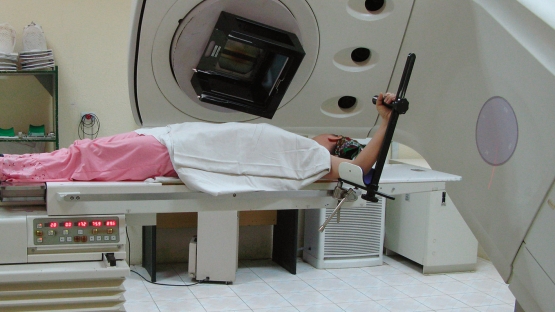Lower than standard doses of radiation could be sufficient for the treatment of certain cancer types, limiting radiation exposure for patients and decreasing health care costs, indicated results of clinical research trials presented last week in Barcelona at a special IAEA session of the 3rd ESTRO Forum held from 24 to 28 April. ESTRO — the European Society of Radiation Oncology — is the second largest radiation oncology forum and conference worldwide, bringing together medical professionals and organizations from around the globe. The session’s experts shared the results of seven IAEA-supported clinical trials, randomized studies and surveys.
“IAEA clinical studies focus on identifying radiotherapy treatment strategies that are effective while being resource-efficient and more convenient for patients,” said Eduardo Rosenblatt, Head of the Applied Radiation Biology and Radiotherapy Section at the IAEA. “This is particularly important for low-income countries where radiotherapy centres are often overloaded with patients, understaffed and rely on limited resources for treating patients with more advanced diseases,” he said. “By finding ways to provide effective treatments that require fewer resources and shorter treatment times, more patients can get the treatment they need.”
Clinical trials and randomized studies are important avenues for understanding the effectiveness of drugs and treatment methods in medicine. They help in identifying shortcomings, facilitating development and improving management and care for health conditions and diseases like cancer. As the results are confirmed with further patient follow-up, the findings could influence mainstream cancer care treatments in the coming years, resulting in significantly lower radiation exposure to the average patient, Rosenblatt explained.
The session’s presentations featured five studies and trials on radiation treatments for cancer of the head-and-neck, breast, rectum, bone and lung, as well as two investigative surveys of radiotherapy capacities in developing countries. These were conducted with support from the IAEA and in collaboration with Member States and other organizations. The following results were presented:
Clinical trials and randomized studies on cancer treatment
- Advanced head-and-neck cancer: A randomized study of 104 patients showed a treatment advantage when combining six radiotherapy treatments per week with a drug that sensitizes cancer cells to radiation, known as a radiosensitizer nimorazole, compared to only administering the typical six radiotherapy treatments per week. The radiosensitizer nimorazole drug helped the radiation to be more effective.
- Locally advanced lung cancer: A clinical study demonstrated that a shorter course of radiation showed similar results as the standard, longer course of radiotherapy used for survival and for mitigating symptoms of lung cancer.
- Post-mastectomy breast cancer: A clinical trial involving 496 patients found that after removal of the breast, irradiation of the lymph nodes in the area around the collarbone may not be necessary in treating breast cancer patients.
- Locally advanced rectal cancer: A preliminary analysis of a randomized clinical trial revealed that the results of a short course of radiotherapy (five treatments in one week) and surgery is equivalent to longer course radiotherapy (25 treatments in five weeks) and chemotherapy. Currently, the longer course radiotherapy and chemotherapy is the general treatment protocol for this type of cancer when it is in its advanced stages.
- Bone growths (metastases): A randomized clinical trial established that giving a single higher dose of radiation treatment is significantly more effective than a single lower dose for managing pain caused by cancer growths in bones.
Increased radiotherapy capacity in middle-income countries
In addition to the clinical trials, presenters also shared the results of research on cancer care capacities in various countries. One survey showed an increased use of radiotherapy machines in nine middle income countries, which was found to be comparable to the use levels in developed countries. Another presented data collected in 12 countries in Eastern Europe, the Caucasus region and central Asia, showing the number of radiotherapy centres, machines and staff available in the region — the first time such data had been compiled for these countries. This data will be combined with a second project phase assessing the quality of radiotherapy services. The data sets will form the first comprehensive overview of cancer care capabilities in these countries, which is expected to influence how they plan radiotherapy services.
“Planning radiotherapy services in a country or region requires a robust estimate of demand, as well as reliable data on existing resources. However, a description of the number of facilities and machines is not enough to assess patients’ access to services or the quality of treatments,” said Elena Fidarova, a radiation oncologist at the IAEA. “This project will paint a reliable picture of the status of radiotherapy services, which can help the IAEA and other organizations to focus their specific priorities when collaborating with these countries in developing their cancer care capacities.”
Last week’s session marked the first time that the IAEA received a dedicated presentation time during the ESTRO Forum. “The IAEA has a long-standing history of collaboration with ESTRO, mainly in the area of radiotherapy education,” said Rosenblatt. “In the last few years, this collaboration has strengthened, particularly through participation in IAEA coordinated research projects. In the future, we expect this collaboration to continue and to bring further developments to the field of radiation oncology.”



